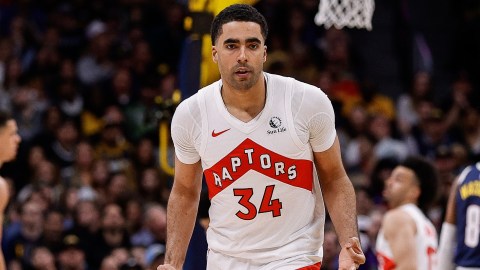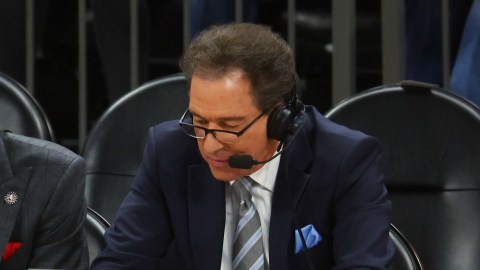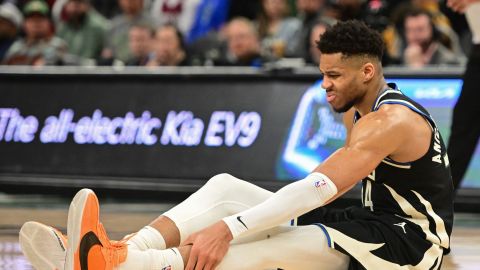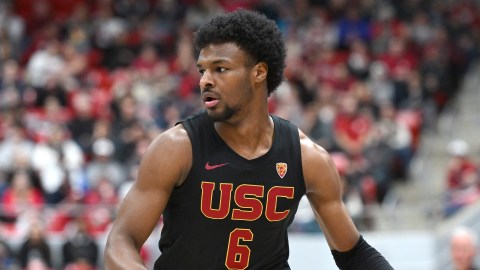Charming. Role model. Fundamentals. Youth leader. These were the words used to describe Stephon Marbury in an interview with Sam Roberts on local New York station NY1 in 1994.
“I want to be a lawyer,” Marbury even said.
Considering the subsequent 16 years of Starbury’s journey, these words seem almost unthinkable.
It may not be as surreal as watching O.J. Simpson in Naked Gun movies or Lindsay Lohan as two cute and innocent twins in The Parent Trap, but seeing the former high school phenom composed and upstanding, without his logo tatooed on his head really makes you wonder: “How did things turn out as like this?”
Before LeBron James, Marbury was about as big of a high school hoops legend as you could be. He came from a family of basketball talents who were well-known in Brooklyn and, unsurprisingly, starred at basketball powerhouse Abraham Lincoln High School in the borough. A celebrity well before he turned 18, Marbury was lionized in his neighborhood Coney Island and hyped as the next big thing, a rite of passage for young basketball players growing up in New York City.
Marbury won the title of New York State Mr. Basketball, was heralded as the top guard recruit in the country and starred in the McDonalds All-American Game before heading to play at Georgia Tech.
Things couldn’t have been going better.
In his one season with the Yellow Jackets, Marbury impressed, being named an AP Third Team All-American. Even as a freshman, he lived up to his “Starbury” hype. He outshined everybody else on the floor.
Starbury left Georgia Tech “one and done” before it was commonplace, but the decision was hard to argue. The Milwaukee Bucks drafted the Brooklyn legend and immediately traded him to the Minnesota Timberwolves for Ray Allen.
Paired with a young Kevin Garnett, the T-Wolves were competitive in the Western Conference, making the playoffs consistently, but that wasn’t enough.
Marbury had to live up to the hype.
His flash made him turnover prone, and he took too many shots, particularly 3s, which he only shot at about a 30 percent clip. He could have been dumping the ball to a dominant KG, but either because of expectations or personality, that’s not what Marbury did.
Starbury got himself traded to the Nets in 1999. Back around his home turf, Marbury starred in his three seasons with New Jersey, but there was one problem: The Nets weren’t very good. Maybe it was because their second-best player was Keith Van Horn, or because they were coached by a guy meant to be in college, John Calipari, but the Starbury Nets couldn’t win.
The year after Marbury left New Jersey for Phoenix in a swap for Jason Kidd, that magically changed. As for the Suns, they weren’t very good in his first year, still featuring NBA Jam relics Tom Gugliotta and Dan Majerle, but with the additions of Shawn Marion and Amare Stoudamire, the team made the playoffs in 2003.
Just a year thereafter, the Suns traded Marbury away. When his eventual successor, Steve Nash, took over at the point in Phoenix, the team got a whole lot better.
Finally with his hometown New York team, Marbury starred in an era of Knicks despair. He was the centerpiece on a team of poor decisions. In 2004, Starbury proved how incapable of winning he was, taking home bronze in the Athens Olympics (while setting a scoring record, of course).
After years of disputes with his coaches and GMs, Starbury faded into anonymity. He even thoroughly alienated his hometown fans, who had previously so loved him. While he would finally make the second round of the playoffs as an ill-advised midseason flyer by the Boston Celtics in 2009, no franchise was willing to take a chance on him after that season.
So, what went wrong?
The easiest argument to make is that Marbury was more flashy than he was good. Perhaps receiving so much attention encourages a certain style of play: launching 3s, AND1 assists, hogging the ball, all at the expense of defensive effort. But whatever the cause, that’s the reality of how he plays.
As a result of his penchant for shooting the ball, the New York star functionally is a combo guard, not a point guard or shooting guard.
In the NBA, the history is pretty clear. Teams with a distinct point guard and shooting guard win. Teams that don’t follow that formula lose. Even Dwyane Wade has struggled to get wins, Shaq partnership aside. You could say the same thing about Allen Iverson as well.
Marbury’s defense also wasn’t just bad. It statistically overshadowed his offense. For his career, Marbury created 108 points per 100 possessions while individually giving up 110. Steve Nash, a similarly poor defensive player, creates 119 per 100 with the same defensive rate, giving him a plus-nine differential in contrast to Marbury’s minus-two (the best in the NBA for a career currently is Tim Duncan at plus-15).
Even so, Marbury is still not that old (33), and incredibly talented as a scorer. There must be something else wrong with him.
But we all know what it is. He’s impossible to play with unless it’s all about him. He couldn’t defer to KG. New Jersey and Phoenix couldn’t build winners until he left. New York was incompetent with him as its star. He may be a sight to see on the basketball court, but that doesn’t make him a teammate or a winner.
His desire for the spotlight resulted in more and more outlandish moments as his basketball stardom faded. He tatooed his head like Mike Tyson and ate Vasoline in a crazed rant on YouTube.
This past Friday, Marbury made news for being sued for claiming to maintain ownership of some of his business holdings, which he apparently sold for one dollar earlier this year, and it should come as no surprise that he has had issues with bankruptcy.
Still, we can’t help but remember the good that Marbury has done. As a youth, he was a legitimate role model for underprivileged urban kids in his community. As an adult, he has given millions of dollars to help those same communities. In interviews, you really can get the sense that he cares about where he came from and sincerely wants to help. He’s not just doing it for PR.
His most thoughtful move may have been his 2006 decision to forgo shoe deals with the big companies to produce a shoe that he could sell for just $14.98. Most kids struggle to pay the $120 for Jordans, but Marbury made shoes that everybody could buy. It was legitimately noble.
Today, Marbury plays for the Shanxi Zhongyu Brave Dragons in the Chinese Basketball Association. The superstar of the world’s largest basketball market, Marbury receives all of the attention that he craves and dominates the basketball court just as he did as a youth in Brooklyn.
And when I say dominate, I mean dominate.
You have to wonder, though: Is this Marbury’s ultimate hoops destiny? The first real star to play in China, Marbury may go down as a forerunner in sports globalization, a massively pivotal figure in sports history.
But if he doesn’t ever return to the NBA and prove that he can be a teammate and a winner, will his legacy at home ever be anything but that of a squandered talent?
He still has basketball left in him, but it would be hard to believe that any championship team would take a chance on him. Maybe a team like Memphis would bring him in to fill seats. A T-Wolves homecoming would make some sense as well. If he was to succeed in such a challenge, then perhaps a legitimate title contender would take a chance on him as a veteran piece.
Redemption is possible.
Still, with regards to Stephon Marbury, we should’ve learned that we can’t predict anything.



